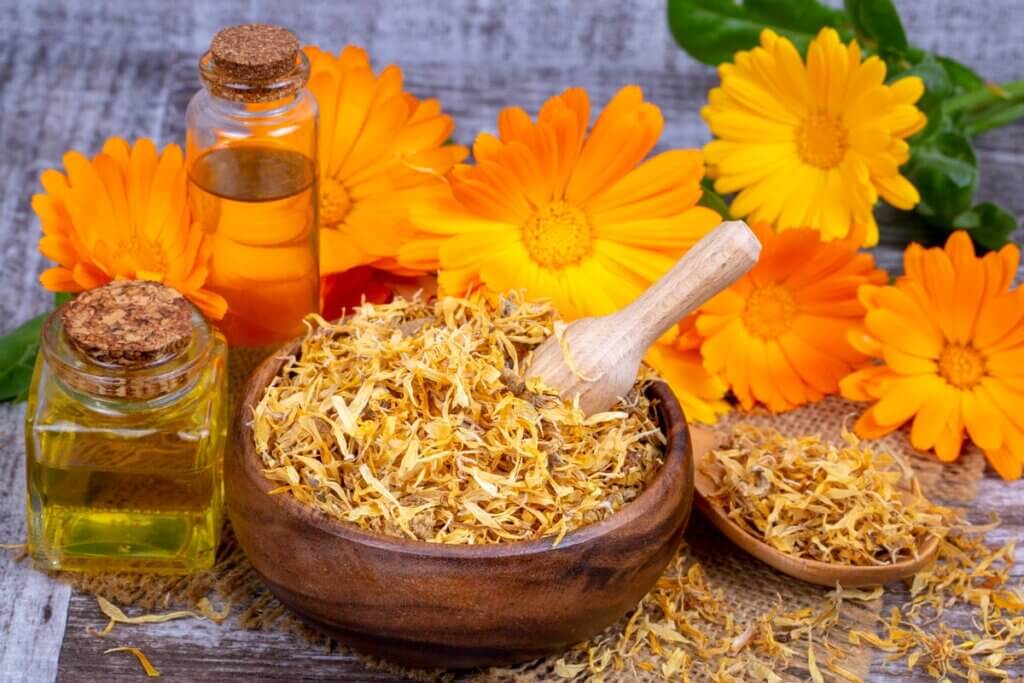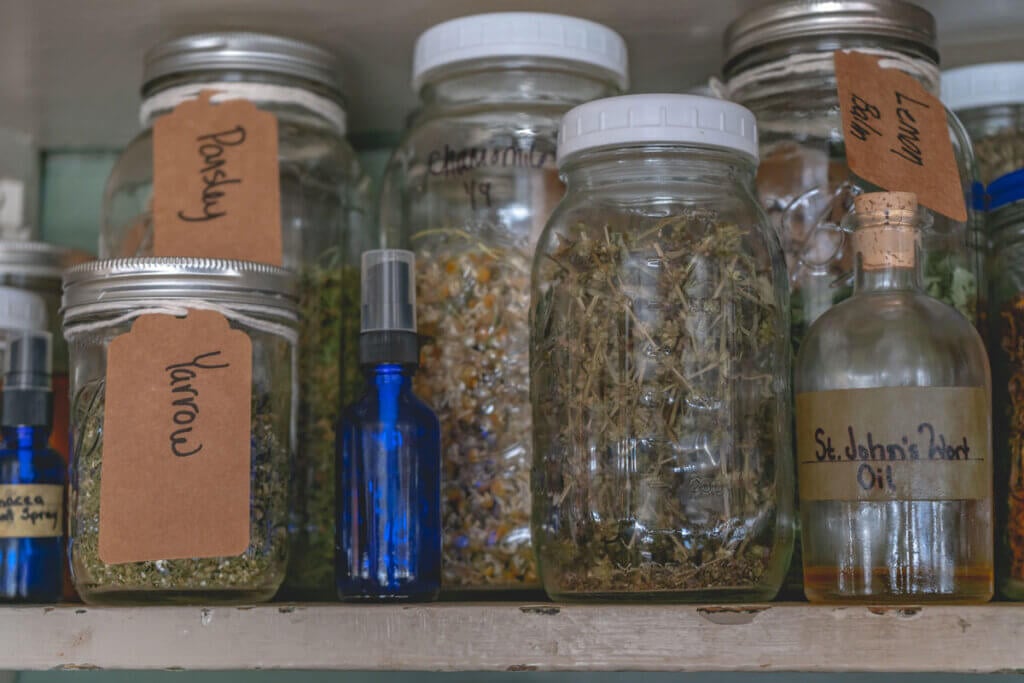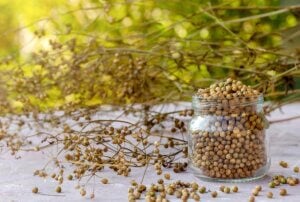You may recognize calendula flowers as an ingredient in your face cream or skin oil, but you can use this plant for much more!

Calendula, a vibrant and versatile herb, captures the hearts of gardeners, herbalists, and wellness enthusiasts alike for its numerous health benefits and versatile uses.
Bursting with a brilliant sunshine hue, we recommend you plant this cheerful flower in your garden. Read on to find out why!
Why I Love Growing Calendula Flowers
Stepping right out our door into our old-fashioned cottage garden allows us to grow herbs for culinary, medicinal, and ornamental purposes. The sights and smells of the herbs and flowers bring beauty and well-being.
We use our herbs to help us achieve self-sufficiency and independence in our health. In a sense, it helps us go “off-grid” with our health. We are happy we learned how to use herbs for healing. Little by little, we added to our knowledge of how to use herbal medicine safely at home.
Designing our cottage garden encouraged us to research medicinal herbs and their uses. Years later, we feel confident recommending these 15 medicinal herbs to grow, harvest and how to use them for the beginner herbalist.
Calendula (Calendula officinalis) makes the list of medicinal herbs that we include in our gardens. We harvest it for medicinal purposes and flower bouquets in our home. It is also a plant that works well for companion planting in the vegetable garden.
Plant calendula if you want to learn how to attract pollinators to your home garden. This vibrant daisy-like flower provides beauty, health benefits, and garden support. We can’t recommend it enough!

Varieties of Calendula
Marigold Calendula encompasses a range of beautiful varieties, each with its own unique charm. Some popular cultivars include:
- Calendula (Calendula officinalis) – This is the most common variety, known for its bright yellow or orange flowers with a tangy fragrance. Best used for medicinal purposes and is perfect for all hardiness zones.
- Resina Calendula – This variety is the best to grow for medicinal purposes. It contains high amounts of resin, which offers potent medicinal benefits, like anti-inflammatory properties. Resina Calendula grows as a bushy plant, making it a less appealing choice if you use flowers for bouquets.
- Orange King Calendula – A timeless classic with massive bright orange petals, it showcases the epitome of calendula’s warm, sun-kissed radiance. This variety needs full sun and requires rich, healthy soil.
- Lemon Zest Calendula – As refreshing as a ray of sunshine, this yellow-flowered variety blooms for the most prolonged duration of any of the calendula plants. It is also a dwarf variety that can grow well in a container garden.
- Touch of Red Buff Calendula – This bicolor variety features a unique blend of cream and reddish hues, making it a standout choice for gardeners seeking something visually appealing. It grows 24 inches tall, is hardy, and produces edible flowers.
- Snow Princess Calendula – A delightful white-flowered variety that adds a touch of elegance to any garden. Gardeners love it for its aesthetic appeal in floral arrangements. It grows well in container gardens and supports the cut-and-come-again method.
- Bon Bon Calendula – Sporting unique apricot-colored petals, this variety stands out with warm and inviting hues. This dwarf variety grows well in most soil types and withstands frost.

Health Benefits of Calendula
It’s important to note that I am not a certified medical practitioner. This post is not intended to diagnose or treat but is for informational purposes only. Please contact your medical care professional before introducing new herbal remedies into your wellness routine.
Calendula is well known for its benefits to the skin. You can find calendula in herbal salves, body washes, lotions, and shampoos. Like the comfrey plant, it soothes the skin and offers anti-inflammatory properties and accelerates healing. (Source)
Beyond its visual appeal, calendula flowers possess an impressive array of medicinal properties, such as flavonoids, carotenoids, and essential oils, and have been used for centuries in traditional medicine. (Source) Here are some notable health benefits:
- Skin Healing – Calendula’s natural antiseptic and anti-inflammatory properties make it an excellent choice for soothing skin irritations, such as rashes, cuts, burns, and insect bites. (Source) Check out this post where I share a calendula sunburn soothing salve.
- Wound Care – The plant’s antimicrobial properties promote wound healing by preventing infections and reducing inflammation. Calendula-infused oils or creams are often used topically for this purpose. (Since calendula promotes speedy wound healing, it is important not to use it on deep wounds, puncture wounds or wounds that are not clean.) (Source)
- Immune Support – The plant’s flavonoids and antioxidants help boost the immune system, aiding in overall wellness and protection against various illnesses. (Source)
- Digestive Aid – Calendula tea can assist in alleviating digestive issues like indigestion, stomach ulcers, and inflammation in the digestive tract. (Source)
- Lymph Stimulant – Calendula offers support for swollen glands. (Source)

Ways to Prepare Calendula
You can eat calendula flowers and leaves, but not the center of the flower. The leaf’s bitter taste work best sprinkled in salads. Most people just harvest the petals for use in medicinal and culinary efforts.
Calendula can be prepared and used in various forms to harness its benefits. Here are a few popular methods:
- Calendula Oil – Infusing calendula flowers in carrier oils, such as olive or coconut, creates a potent healing oil. You can apply it topically to nourish and soothe the skin. It can also ease muscle spasms.
- Calendula Tea – Brew dried calendula petals into a fragrant tea. This makes a soothing beverage that aids digestion and supports overall immune support. (Source) To improve the flavor, combine it with herbs like peppermint or lemon balm and add a spoonful of honey.
- Salves and Balms – Calendula extracts can be incorporated into ointments, salves, and balms for effective skin healing and protection. You can use it in a soothing burn salve and homemade antibiotic ointment (better than Neosporin). Due to its antifungal properties, it helps heal rashes and wounds, including diaper rash. (Source) Calendula (along with Bee Balm) are the primary herbs used in the bag balm I make for our dairy cow.
- Tinctures and Capsules – You can take small doses of calendula for its immune support, anti-fungal properties, antimicrobial effects, digestive aid, and more. Make your own herbal tinctures or homemade herb capsules to take small doses of calendula.
- Culinary Uses – Commonly used as a saffron substitute, add a burst of color and a subtle tang to your culinary creations by sprinkling fresh or dried calendula petals into salads, soups, or desserts.
- Dyes or Cosmetics – Historically, people used calendula flowers to dye fabrics or to make powdered cosmetics.

Growing Calendula
Calendula, a flowering plant that boasts yellow-orange tones, is also called pot marigold. This beautiful flower makes a great addition to the garden. Its orange or yellow petals attract pollinators and beneficial insects.
Although calendula is an annual, it drops its seeds and returns year after year. Calendula can withstand direct sow methods or transplant methods. Learn when to start seeds indoors and how to start seeds indoors for more seed-starting tips.
Over 100 varieties of calendula exist, making choosing which seeds or plants to buy confusing. Learn how to choose the best vegetable seeds for your garden and how to read seed packets to help you make your selection.
Although native to southern Europe, it grows well in a variety of climates all over the world. One of the many joys of calendula lies in its ease of cultivation, making it an ideal choice for both seasoned gardeners and newcomers alike.
Planting
- Sun and Soil – Calendula thrives in full sun to light shade (depending on the variety) and well-draining soil. It is relatively forgiving and can adapt to various soil types, from sand to clay.
- Sowing Seeds – Plant calendula seeds directly in the garden after the last frost. Or start seeds indoors 6-8 weeks before the frost date for an early bloom, transplanting after the last threat of frost has passed. Calendula plants transplant well. Sow seeds ¼ inch to ½ inch deep.
- Watering – Keep the seeds moist until they begin to sprout.
- Companion Planting – Calendula pairs well with tomatoes. They help each other grow to their full potential, and calendula repels harmful pests. Cucumbers, carrots, spring salad greens, peas, and asparagus are other great companions.
Growing
- Watering – Keep the soil moderately moist throughout its growing season. Do not over-water.
- Deadheading – Remove the flower heads when they wither or turn brown to prolong blooming (or harvest just after they have opened fully for the best medicinal properties – this will act as deadheading as well).
- Thinning – After your seed comes up, thin your calendula seedlings at least 8 inches apart.
- Fertilizing – We do not recommend fertilizing calendula. They tend to produce more flowers without any fertilizer.
- Weeding and Mulching – Calendula does well with a layer of mulch. This helps deter weed growth and retains moisture.
Harvesting
- Harvesting – Harvest calendula flowers when they are just fully open and vibrant. Ideally, they should be slightly sticky when you harvest them. When you cut flowers, more will grow within two weeks.
- Self-Sow – Calendula plants self-sow extremely well, so do not remove your calendula plants from your garden at the end of the season. Leave a handful of flowers on the stem to drop their seeds in the fall. You will not need to replant calendula next year.
- Storing – Air-dry calendula flowers completely and store them in a dry, airtight container (I use Mason jars).
Preserving
- Drying – Dry calendula petals in a well-ventilated area, away from direct sunlight. Learn how to dry fresh herbs (oven, dehydrator, or hanging). As preservation methods, you can use these dried petals in your herbal teas, tinctures, salves, or herbal capsules.
- Oil – You can make calendula oil to preserve it using fresh or dried calendula petals.

Using Herbal Medicine
From its vibrant varieties that brighten up gardens to its remarkable health benefits and versatility in culinary and wellness applications, calendula is truly a treasure among herbal wonders.
Whether you’re an avid gardener, a wellness enthusiast, or just getting started on your journey, join our Herbal Medicine Cabinet: Colds and Flu Class to learn more.
Happy gardening and herbal medicine exploration!



















